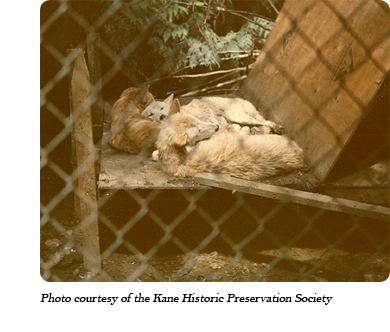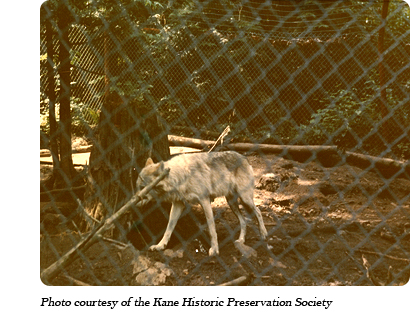Jack Lynch's "Loboland USA" Wolf Park at Gardiner, Washington
 In February 1972, Jack and Marjorie Lynch moved the lobo wolf park from near Kane, Pennsylvania to Gardiner, Washington, a small community located on the Olympic Peninsula in Jefferson County, adjacent to Clallam County. The location was chosen for its proximity to the Olympic National Park and the ocean, which made the location highly visible to tourists.251 Also nearby were ranches and farms from which Jack could procure meat for the wolves.214
In February 1972, Jack and Marjorie Lynch moved the lobo wolf park from near Kane, Pennsylvania to Gardiner, Washington, a small community located on the Olympic Peninsula in Jefferson County, adjacent to Clallam County. The location was chosen for its proximity to the Olympic National Park and the ocean, which made the location highly visible to tourists.251 Also nearby were ranches and farms from which Jack could procure meat for the wolves.214
The new park was known as "Loboland USA" and the "Pacific Wolf Preserve." It consisted of 40 acres of land and the wolves were kept in 30 individual 40-by-80-foot pens which were separated by walkways and covered about 10 acres. Each pen held 2 to 8 wolves, which Jack chose to put together to form packs and maintain specific bloodlines.191,214
In February 1974 the Lynches founded the Dr. E. H. McCleery Lobo Wolf Foundation.1 The name was later changed to the Dr. E. H. McCleery Buffalo Wolf Foundation; it was during his time in Washington that Jack began primarily using the term "buffalo wolf" rather than "lobo wolf." In addition to the buffalo wolves, Jack kept five other wolf subspecies, but eventually decided he had too many wolves and focused specifically on the buffalo wolves.214
 Jack quickly found that the approach he had used in Pennsylvania did not work in Washington. Public perception of wildlife was changing, and as the Washington people did not have the long, fond history with the wolves that the Kane locals did, the park attracted much scrutiny. From many visitors' point of view Loboland was no different from other roadside attractions which peddled animals for profit.218 Instead of being impressed by the claim that these were the last of the lobo wolves (which the Kane people had known to be true), the West Coast visitors generally just felt sorry for the caged animals.146 Visitors reported that the wolves and the park were in poor condition,223,252 and the park was inspected several times and subsequently certified by several federal, state, and local agencies.214 Jack felt he was being over-investigated, and it began to wear on him.214
Jack quickly found that the approach he had used in Pennsylvania did not work in Washington. Public perception of wildlife was changing, and as the Washington people did not have the long, fond history with the wolves that the Kane locals did, the park attracted much scrutiny. From many visitors' point of view Loboland was no different from other roadside attractions which peddled animals for profit.218 Instead of being impressed by the claim that these were the last of the lobo wolves (which the Kane people had known to be true), the West Coast visitors generally just felt sorry for the caged animals.146 Visitors reported that the wolves and the park were in poor condition,223,252 and the park was inspected several times and subsequently certified by several federal, state, and local agencies.214 Jack felt he was being over-investigated, and it began to wear on him.214
The wolves attracted the attention of zoologists and academics who viewed the wolves differently; they recognized the wolves' value and perceived the park to be in good condition.254 Jack made several connections.
 Ronald Nowak examined Jack's records and several of his wolves' skulls, and in December 1974 concluded that although the exact subspecies (Canis lupus nubilus or Canis lupus irremotis) could not be definitely proven, the wolves contained valuable genes that were no longer available in the wild.214 Dr. Durward Allen of Purdue University became a confidant and hoped to include Jack's wolves in his proposed Great Plains National Park, but it never came to fruition.254 Neal Blair of the Wyoming Game and Fish Commission became one of the Foundation's advisors and a personal friend to Jack.139 In general though, Jack disliked and avoided the academic community. He felt that they looked down on him for his lack of formal training, wanted to take credit for his life's work, and wanted to do unnecessary tests on the wolves which were not in the animals' best interests.214
Ronald Nowak examined Jack's records and several of his wolves' skulls, and in December 1974 concluded that although the exact subspecies (Canis lupus nubilus or Canis lupus irremotis) could not be definitely proven, the wolves contained valuable genes that were no longer available in the wild.214 Dr. Durward Allen of Purdue University became a confidant and hoped to include Jack's wolves in his proposed Great Plains National Park, but it never came to fruition.254 Neal Blair of the Wyoming Game and Fish Commission became one of the Foundation's advisors and a personal friend to Jack.139 In general though, Jack disliked and avoided the academic community. He felt that they looked down on him for his lack of formal training, wanted to take credit for his life's work, and wanted to do unnecessary tests on the wolves which were not in the animals' best interests.214
Jack put the welfare of his wolves above all personal comforts. He catered to the public because it was financially necessary for the wolves' support; it was never a profitable venture and Jack was often living below the poverty level.214
In 1976, a woman named Mary Wheeler moved to the area and, being an avid animal-lover, immediately offered to volunteer at the wolf park.217 Jack, who was suffering from a great deal of stress and whose marriage was failing, was usually irritable and rude towards her, so she kept her distance and eventually began to avoid the park.214
Jack made several attempts to secure land for a private preserve for the wolves. By 1977 he had secured funds for a 400-acre preserve but that fell through, causing severe financial setback.193
 To help alleviate mounting costs, the "Adopt a Wolf" program was launched in December 1977. Through this program, adopters sent monthly donations to the Foundation to sponsor a particular wolf. In return a plaque with their name was placed on the wolf's pen and the adopter received free unlimited visiting privileges, a color photo of their adopted wolf, and a brochure.190,193
To help alleviate mounting costs, the "Adopt a Wolf" program was launched in December 1977. Through this program, adopters sent monthly donations to the Foundation to sponsor a particular wolf. In return a plaque with their name was placed on the wolf's pen and the adopter received free unlimited visiting privileges, a color photo of their adopted wolf, and a brochure.190,193
In 1978, overcome with exhaustion and anxiety, Jack fell very ill. At a local store, Mary Wheeler overheard a conversation that the "wolf man" was dying alone in his cabin. Furious that no one had thought to help him, she went to his house, nursed him back to health, and assumed most of the responsibilities at the park. When Jack recovered, she continued to work with him and was especially good at hand-raising the wolf pups.214,217 By the end of 1979, Jack and Marjorie had divorced144 and Mary Wheeler became Jack's partner.192
Jack disliked having visitors at the park and admitted that he only put up with them because the funds were needed. He believed showing the wolves to the public was demeaning for both the wolves and for himself, and he displayed obvious impatience in answering questions. Occasionally visitors would ridicule, poke, or throw things at the wolves; in such cases, Jack would refund the visitors and remove them from the sanctuary, sometimes physically.214 In 1979, he finally closed the park to the public.146,193,214,189
 In 1980, Jack again attempted to secure funding for a preserve for the wolves. Proposed House Bill 1916 would appropriate $50,000 for a temporary holding area in the Cascades (presumably in Washington state) where the wolves would stay until a preserve in the Great Plains could be created for them.145,140 Judging by the subsequent move to Montana, I assume this plan was not successful.
In 1980, Jack again attempted to secure funding for a preserve for the wolves. Proposed House Bill 1916 would appropriate $50,000 for a temporary holding area in the Cascades (presumably in Washington state) where the wolves would stay until a preserve in the Great Plains could be created for them.145,140 Judging by the subsequent move to Montana, I assume this plan was not successful.
All in all, Jack considered moving the wolves to Washington to be a mistake.147 The wolves did not thrive at this location; the climate was not right for them, drainage at the park was poor, and public perception was not favorable.146 No longer soliciting visitors, the park's visibility to tourists became a hindrance. The nearby farmland from which Jack had obtained meat was eventually purchased by developers, again making food for the wolves difficult to obtain.214
Finally, around mid-1980 Jack secured 160 acres of land for a new preserve in Montana about 25 miles north of Yellowstone National Park. This land fit Jack's goals for the wolves - it was expansive, secluded, and was part of the wolves' historic range.189 At the end of 1980, Jack and Mary moved the wolves to their new location in Emigrant, Montana.189
Footnotes
1501c3 Lookup. (2013). E. H. McCleery Buffalo Wolf Foundation. Retrieved from http://501c3lookup.org/e_h_mccleery_buffalo_wolf_foundation/ - Additional information about the Foundation may be found at FindTheBest.com and Faqs.org.
Learn More
Find out more about the Gardiner, WA park by exploring the Locations - Gardiner, WA tag in the archive.
